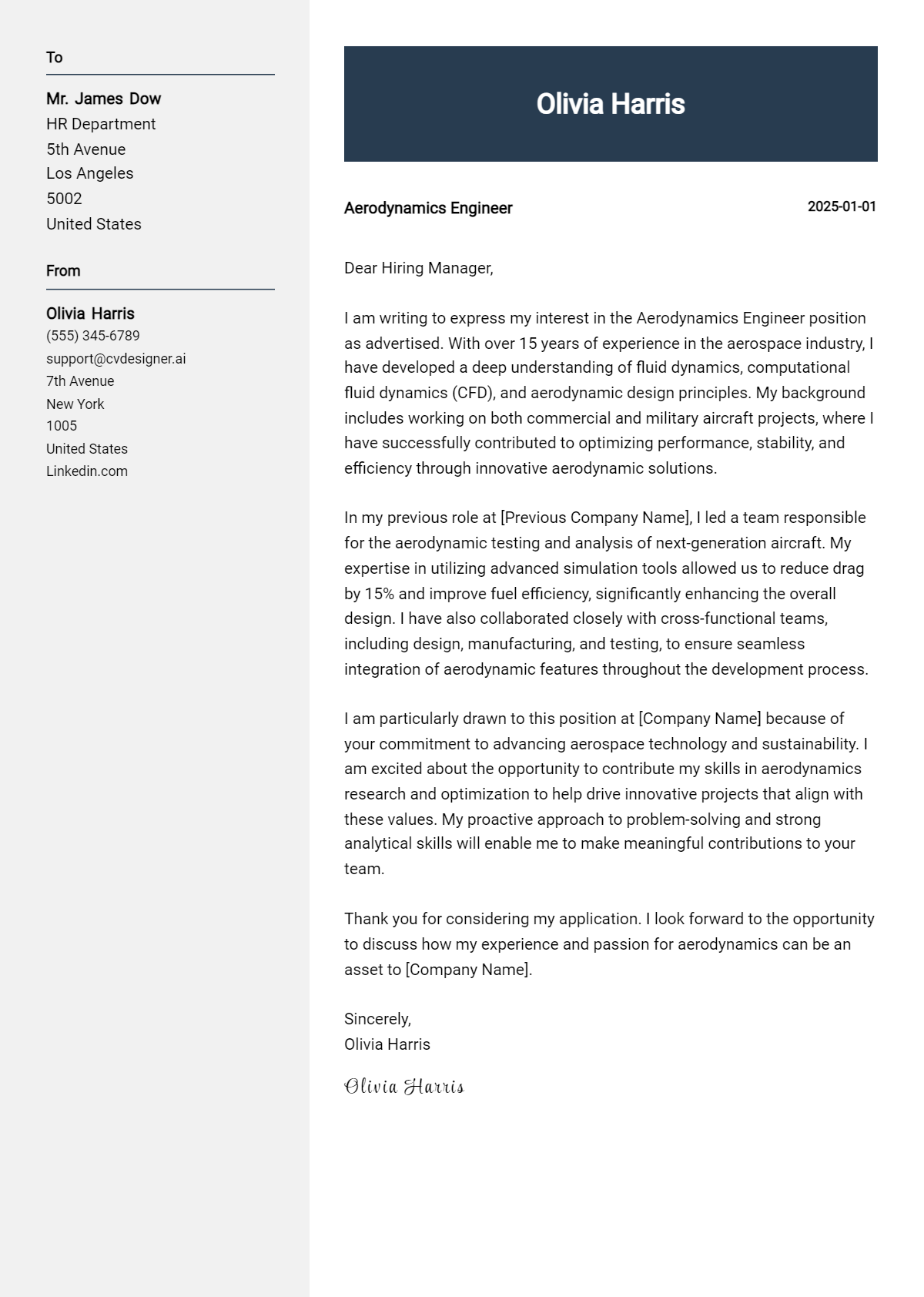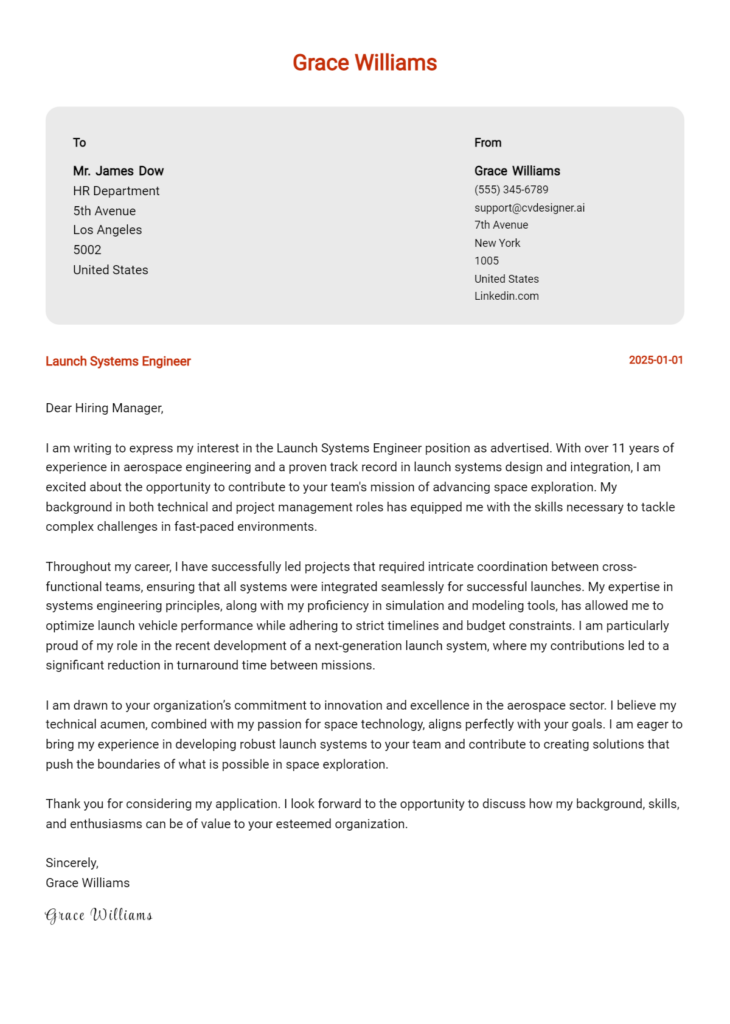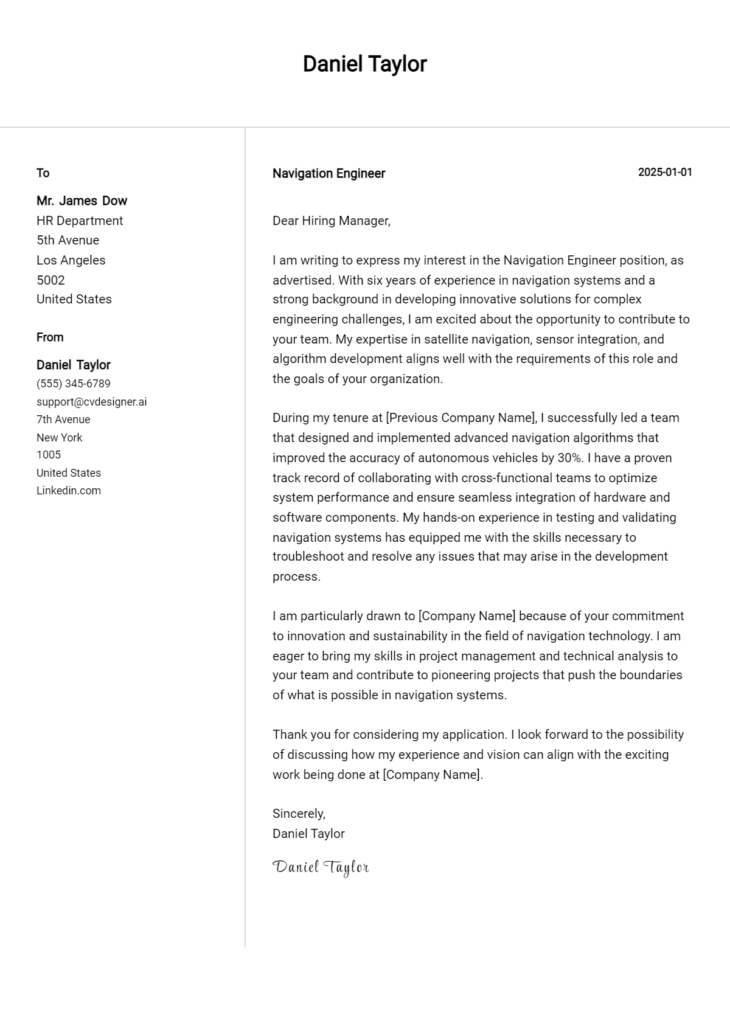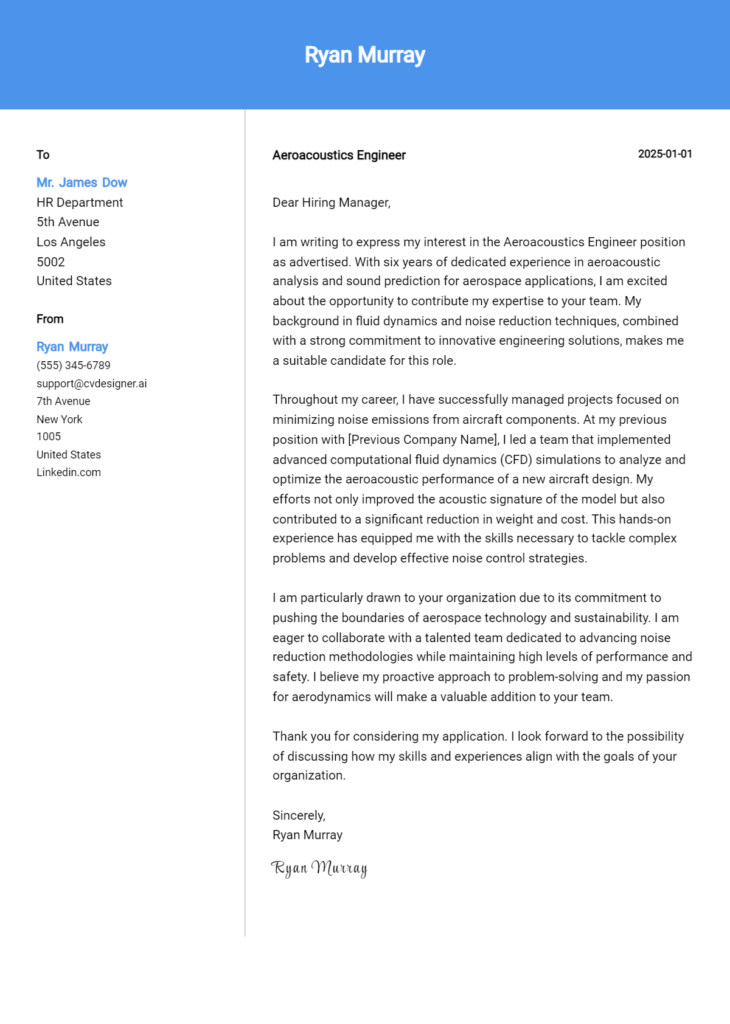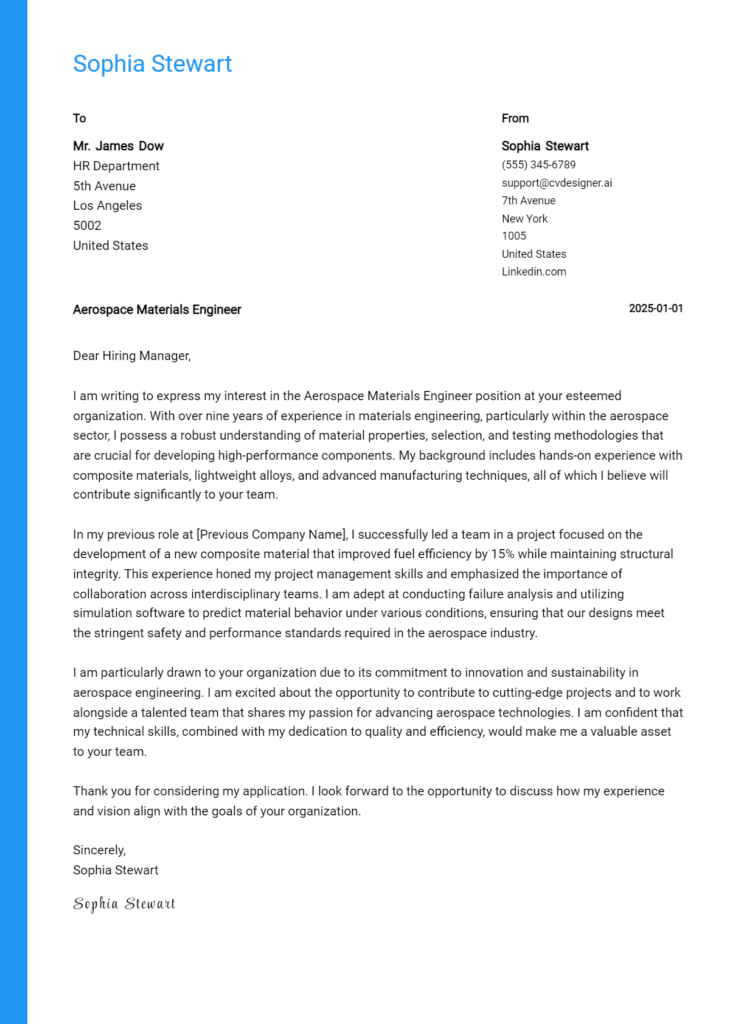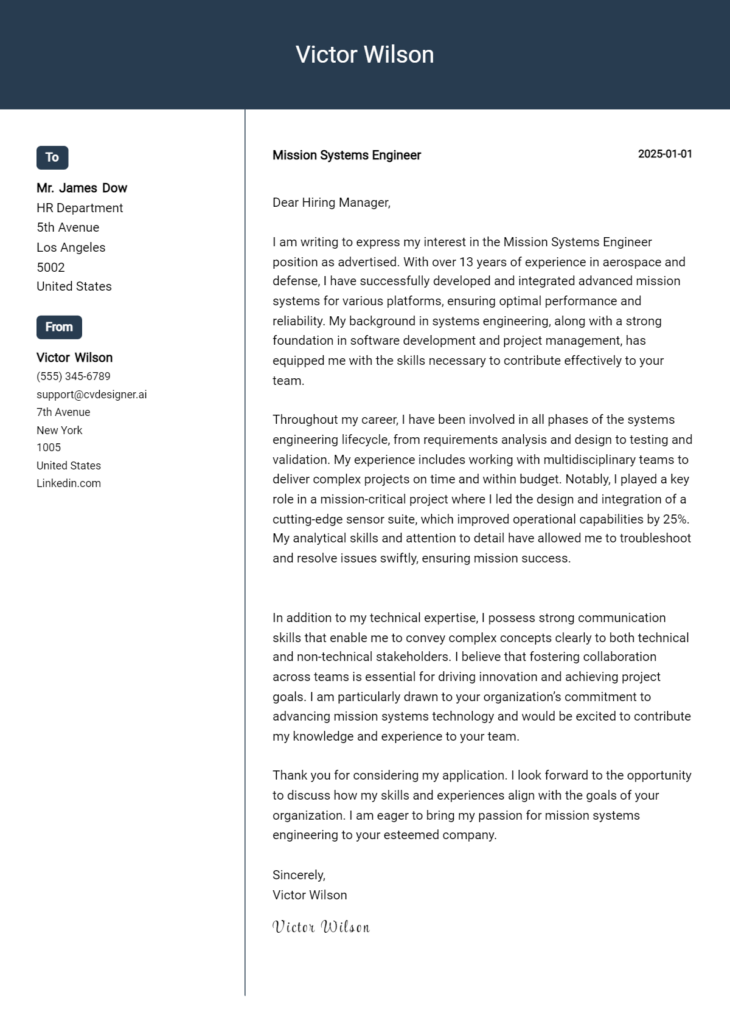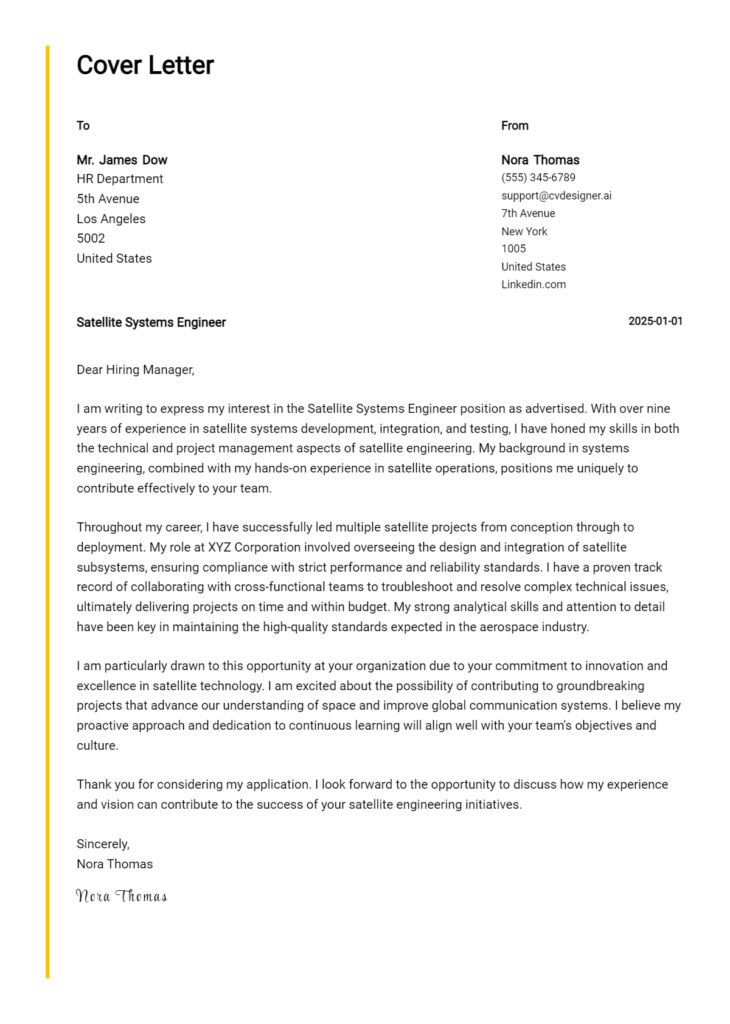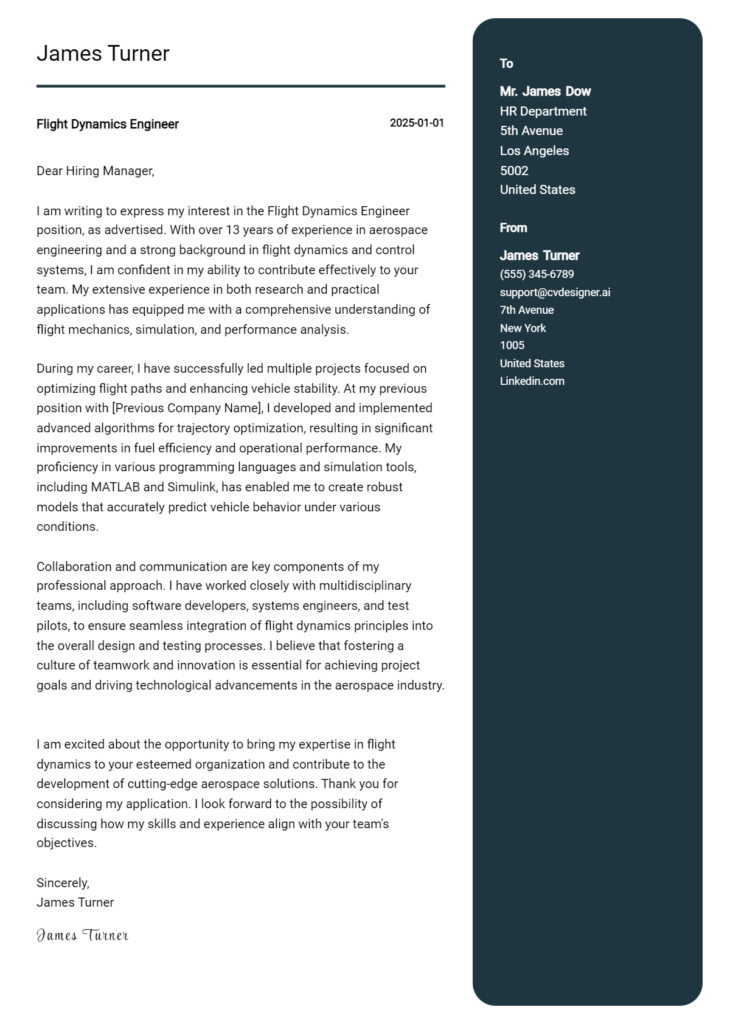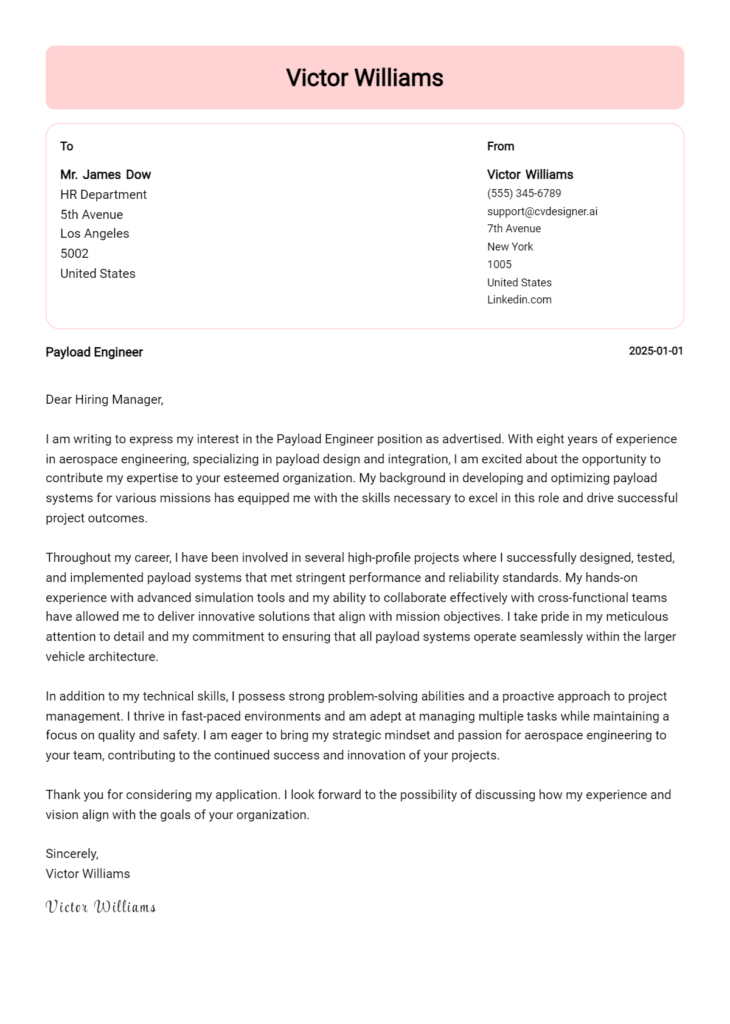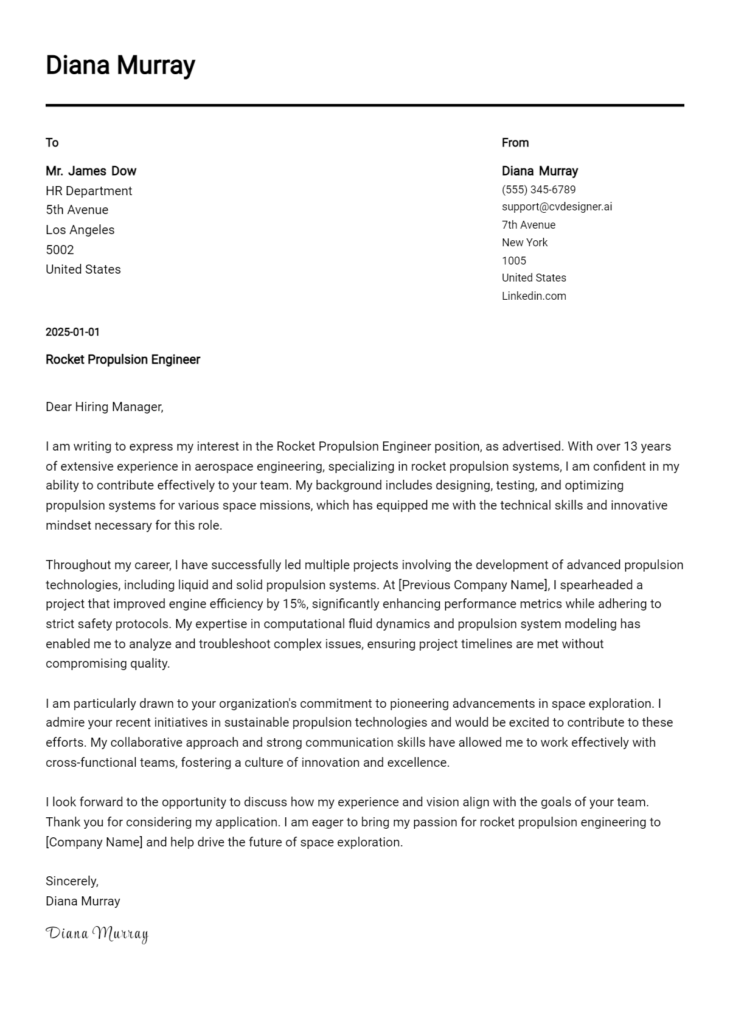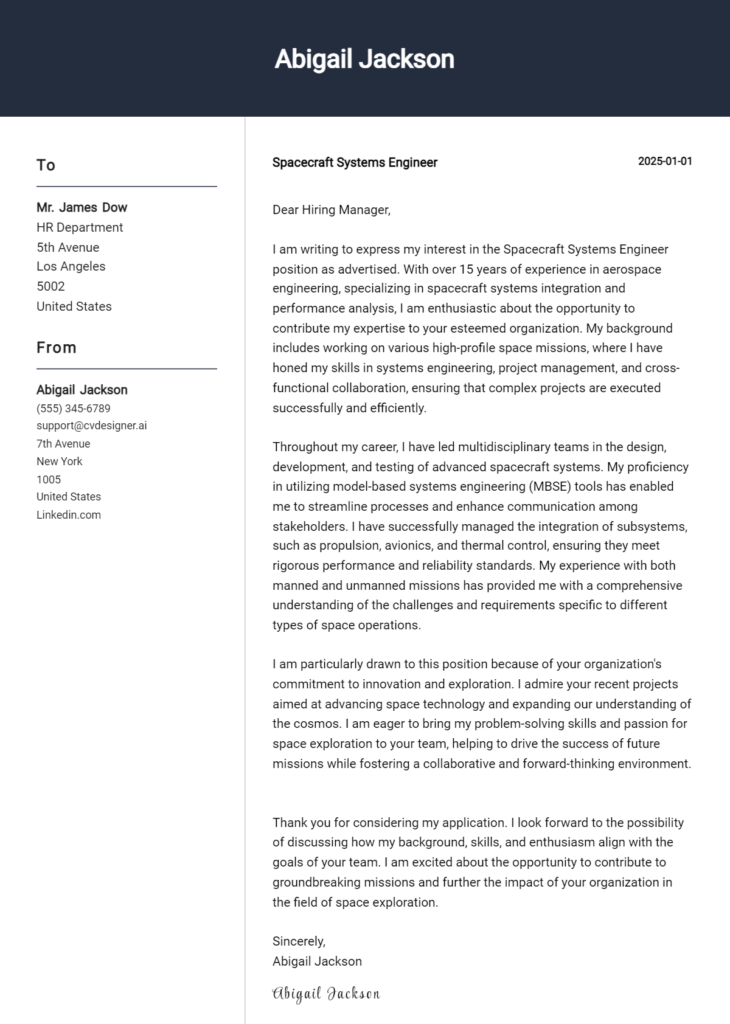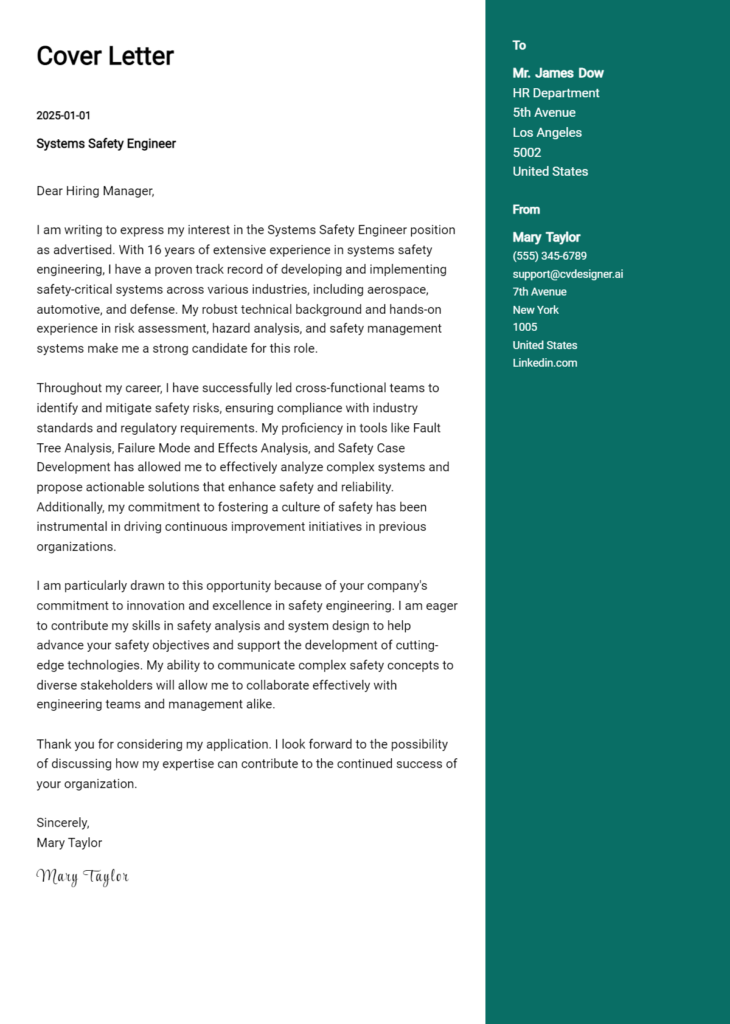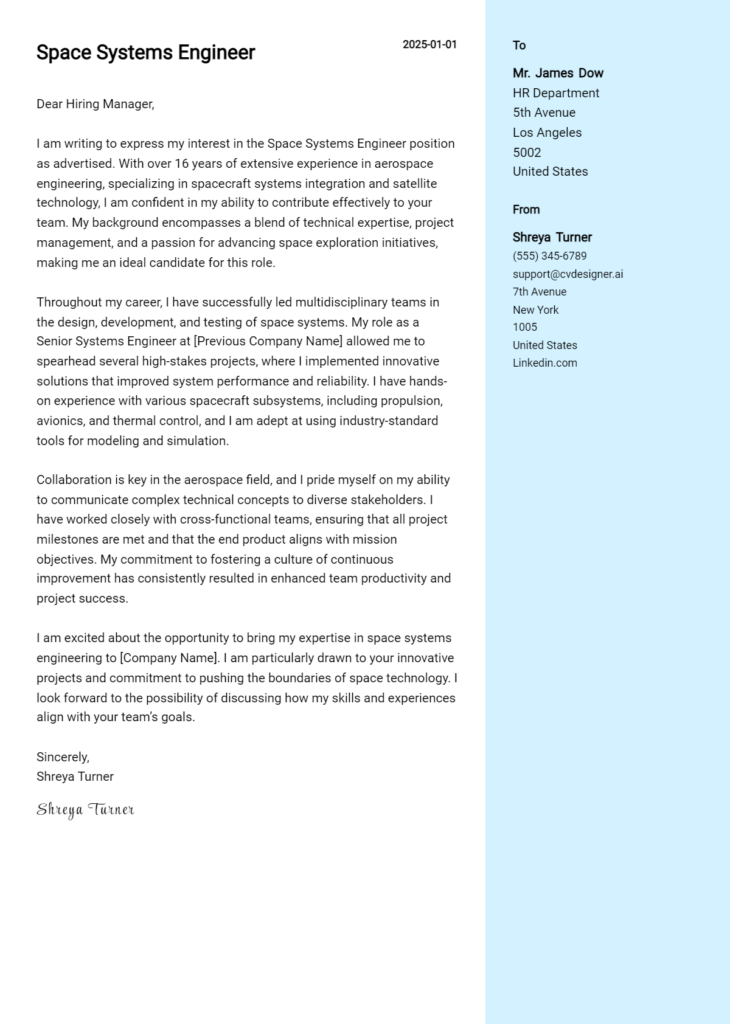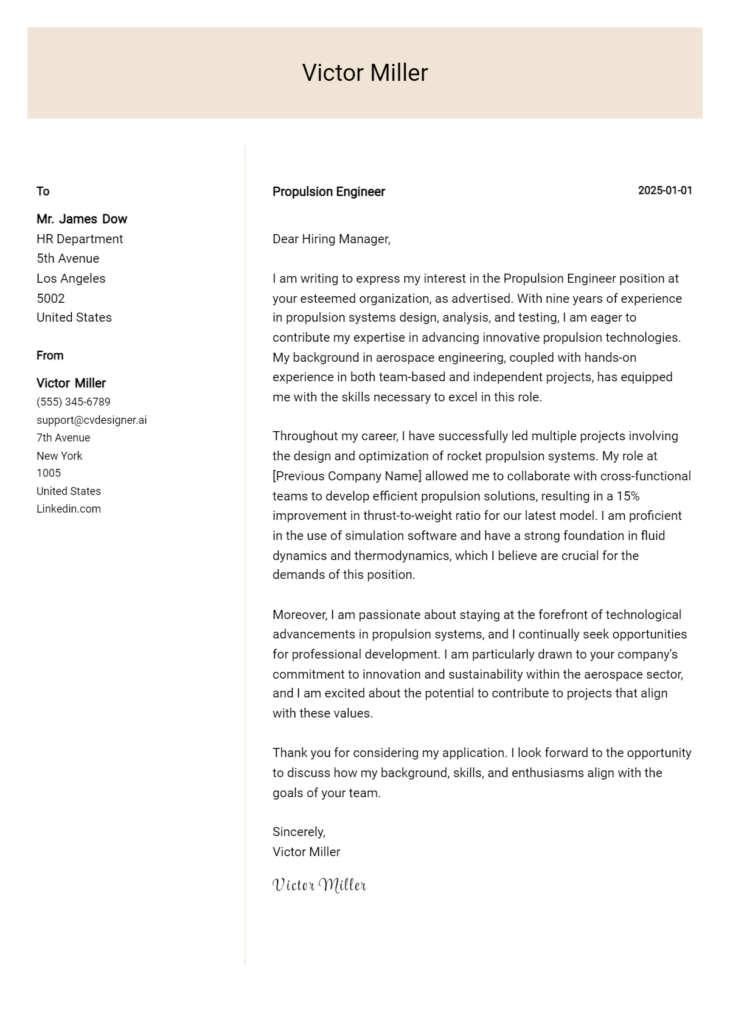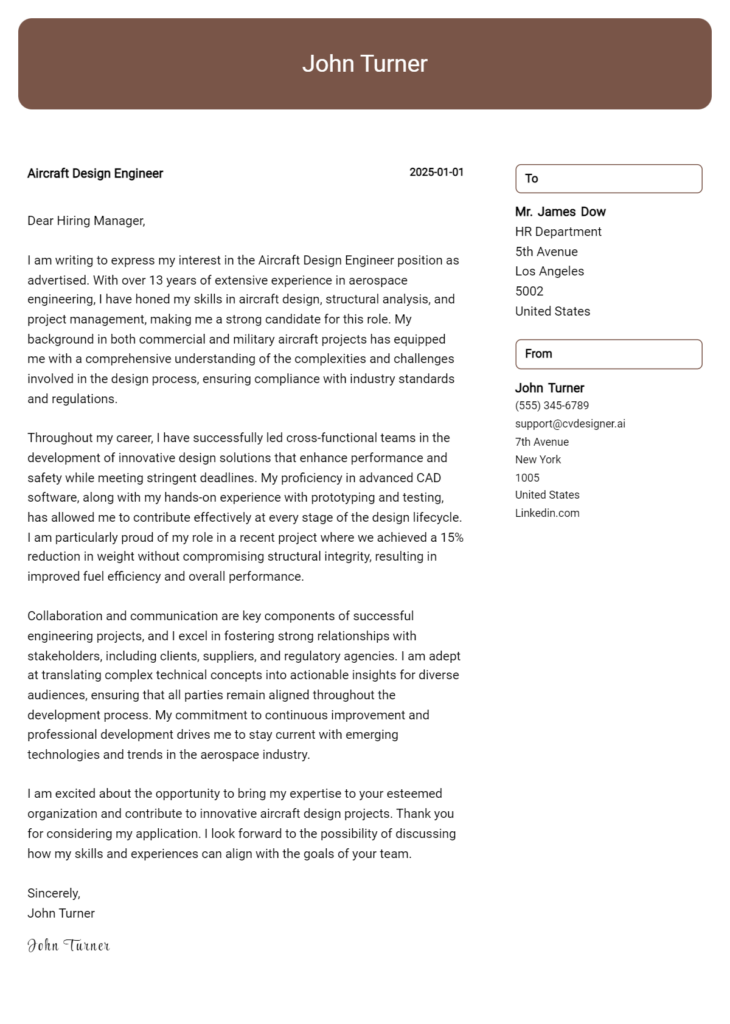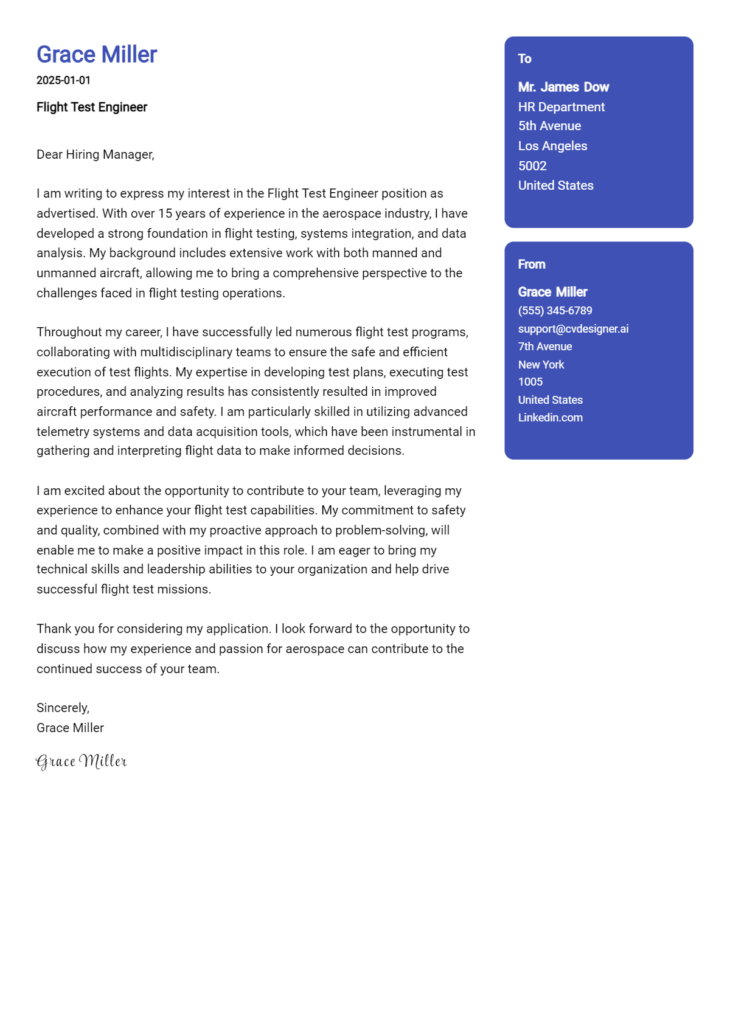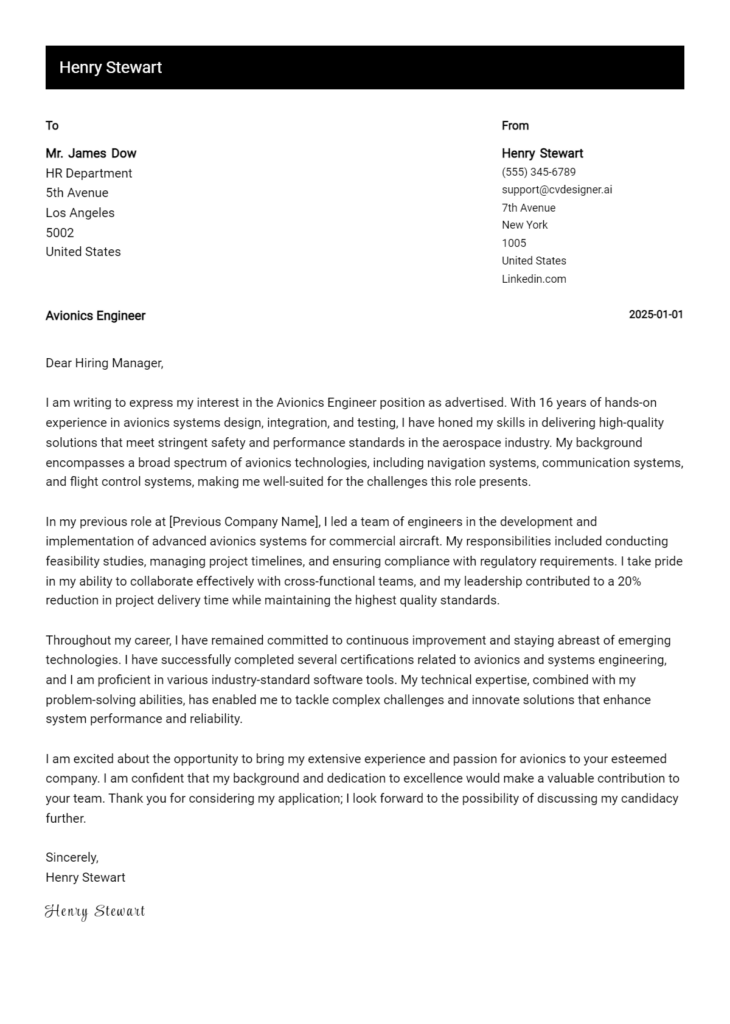Aerodynamics Engineer Cover Letter Examples
Explore additional Aerodynamics Engineer cover letter samples and guides and see what works for your level of experience or role.
How to Format an Aerodynamics Engineer Cover Letter
Crafting a compelling cover letter is essential for an Aerodynamics Engineer, as it not only showcases your technical expertise but also your ability to communicate complex ideas clearly and effectively. The way you format your cover letter reflects your attention to detail and professionalism—qualities that are critical in the field of aerodynamics, where precision can make a significant difference in project outcomes. A well-structured cover letter will capture the hiring manager's interest and provide a strong introduction to your skills and experiences.
In this guide, we will explore how to format your cover letter, emphasizing the unique aspects necessary for an aerodynamics engineering role.
We will cover the essential components of a professional cover letter, including:
- Cover Letter Header
- Cover Letter Greeting
- Cover Letter Introduction
- Cover Letter Body
- Cover Letter Closing
Each section plays a crucial role in presenting your qualifications effectively. Let’s delve into each part and discover how to make your aerodynamics engineer cover letter stand out.
Importance of the Cover Letter Header for an Aerodynamics Engineer
A well-structured cover letter header is crucial for an Aerodynamics Engineer, as it sets the tone for the application and provides essential information to the recipient. The header should include your contact information, the date, and the recipient's details in a clear and professional format. This clarity not only reflects your attention to detail but also ensures that your correspondence is easily identifiable and organized, which is particularly important in engineering roles where precision is key. A strong header can create a positive first impression, while a weak one may detract from the professionalism of your application.
Strong Example
John Doe 123 Aerodynamics Lane Windy City, IL 60614 johndoe@email.com (123) 456-7890 October 1, 2023 Jane Smith Hiring Manager Innovative Aerodynamics Corp 456 Flight Path Avenue Aero City, IL 60615
Weak Example
Hey, My name is John Doe, and I want to apply for the Aerodynamics Engineer job. You can reach me at johndoe@email.com. Thanks!
The Importance of the Cover Letter Greeting
The greeting of your cover letter is crucial as it sets the tone for the entire document. A well-crafted greeting not only demonstrates professionalism but also adds a personal touch by addressing the hiring manager directly. This small yet significant detail can create a positive first impression and engage the reader from the outset. To avoid generic greetings that might make your application seem impersonal, take the time to research the recipient's name or title. This effort shows that you are genuinely interested in the position and have taken the initiative to learn more about the company.
Strong Greeting Example
Dear Dr. Smith,
Weak Greeting Example
To Whom It May Concern,
The Importance of a Strong Cover Letter Introduction for an Aerodynamics Engineer
A well-crafted cover letter introduction is crucial for an Aerodynamics Engineer, as it serves as the first impression to the hiring manager. This introductory paragraph should not only capture the reader's attention but also convey the candidate's genuine interest in the role and briefly highlight relevant skills or achievements. A strong introduction sets the tone for the rest of the cover letter, making it essential to strike the right balance between professionalism and enthusiasm.
Strong Example
Dear [Hiring Manager's Name], I am excited to apply for the Aerodynamics Engineer position at [Company Name], where my extensive experience in computational fluid dynamics and wind tunnel testing can contribute to cutting-edge aerospace projects. With a Master's degree in Aeronautical Engineering and over five years of hands-on experience optimizing aircraft performance, I am eager to bring my skills in innovative design and analytical problem-solving to your esteemed team.
Weak Example
Hi, I want to apply for the Aerodynamics Engineer job. I have some experience in engineering, and I think I could do well in this role. I’ve worked on a few projects in the past, which might be relevant.
Cover Letter Body for an Aerodynamics Engineer
The body of a cover letter for an Aerodynamics Engineer serves as a critical platform to illustrate the candidate's relevant skills, experiences, and the unique value they bring to the prospective employer. By detailing specific projects and accomplishments, the candidate can effectively demonstrate their technical expertise and problem-solving abilities in aerodynamics. Highlighting successful projects—such as participation in wind tunnel testing, computational fluid dynamics simulations, or contributions to aircraft design—can provide concrete evidence of the candidate's capabilities. This part of the cover letter is an opportunity to connect past experiences with the needs of the company, making a compelling case for why the candidate is the best fit for the role.
Strong Example
Dear Hiring Manager, I am excited to apply for the Aerodynamics Engineer position at XYZ Aerospace. In my previous role at ABC Engineering, I led a team on a project that successfully reduced drag on a commercial aircraft design by 15% through advanced computational fluid dynamics simulations. This accomplishment not only improved fuel efficiency but also contributed to the overall design optimization process, which was recognized by senior management. Additionally, my experience in conducting wind tunnel tests and analyzing airflow patterns has equipped me with the necessary skills to tackle complex aerodynamic challenges. I am confident that my technical expertise and innovative approach would be valuable assets to your engineering team.
Weak Example
Dear Hiring Manager, I am interested in the Aerodynamics Engineer position at XYZ Aerospace. I have worked on various projects and have some experience in aerodynamics. I think I would be a good fit for your company. I have used software that is related to aerodynamics, and I am familiar with the principles of fluid dynamics. I hope to contribute to your team and help with your projects.
Importance of the Cover Letter Closing for an Aerodynamics Engineer
The closing paragraph of a cover letter is crucial as it serves to summarize your qualifications, reiterate your enthusiasm for the aerodynamics engineer role, and encourage the hiring manager to take the next steps, such as reviewing your resume or scheduling an interview. A strong closing can leave a lasting impression and reinforce your fit for the position, while a weak closing may undermine the positive message conveyed throughout the letter.
Strong Example
Thank you for considering my application for the Aerodynamics Engineer position at [Company Name]. With a solid foundation in fluid dynamics and extensive experience in aircraft design optimization, I am excited about the opportunity to contribute to your innovative projects. I look forward to the possibility of discussing my application further and how I can add value to your team. Please feel free to contact me at your earliest convenience to schedule an interview. Thank you again for your time and consideration.
Weak Example
I hope you like my letter. I think I would be okay for the Aerodynamics Engineer job. If you want to talk to me, you can call or email, but I understand if you don’t. Thanks.
These tips will help candidates craft an effective cover letter for a position as an Aerodynamics Engineer. A well-written cover letter is crucial in standing out among other applicants by clearly demonstrating your technical skills, problem-solving abilities, knowledge of the software development life cycle (SDLC), teamwork capabilities, and a genuine passion for continuous learning. By highlighting these attributes, you can effectively convey your suitability for the role and your dedication to advancing in the field.
Tips for Crafting Your Cover Letter
Showcase Your Technical Skills: Begin your cover letter by highlighting specific technical skills relevant to aerodynamics. Mention software tools, simulation techniques, and computational fluid dynamics (CFD) applications you are proficient in. Use quantifiable achievements to demonstrate how you've applied these skills in past projects or roles.
Emphasize Problem-Solving Abilities: Aerodynamics engineering often involves addressing complex challenges. Share examples of how you've successfully solved engineering problems or improved designs through innovative thinking. This not only illustrates your analytical capabilities but also demonstrates your resourcefulness and determination.
Highlight Your Knowledge of SDLC: As an Aerodynamics Engineer, understanding the software development life cycle is essential, especially if your role involves developing simulations or design software. Discuss your experience with various stages of SDLC, and provide examples of how you've contributed to projects at different phases, from requirements gathering to deployment.
Demonstrate Teamwork and Collaboration: Engineering is a collaborative field, and showcasing your ability to work effectively within a team is crucial. Describe instances where you have successfully collaborated with other engineers, designers, or cross-functional teams to achieve project goals. Highlight any leadership roles you have taken in these situations.
Express Passion for Continuous Learning: The field of aerodynamics is ever-evolving, requiring professionals to engage in lifelong learning. Mention any recent courses, certifications, or workshops you have attended to enhance your skills. Discuss your enthusiasm for keeping up with industry trends and how you plan to contribute to your employer's goals through ongoing professional development.
By following these tips, you can create a compelling cover letter that stands out. For more inspiration, consider exploring cover letter templates or using a cover letter builder to streamline your writing process.
Common Mistakes to Avoid in a Aerodynamics Engineer Cover Letter
Crafting an impactful cover letter is essential for any aspiring Aerodynamics Engineer, as it serves as your first impression to potential employers. Avoiding common mistakes can significantly enhance your chances of standing out. Here are some prevalent pitfalls to watch for:
Generic Content: Using a one-size-fits-all approach can make your cover letter forgettable. Tailor each letter to the specific position and company. Research the organization and mention relevant projects or values.
Lack of Technical Skills: Failing to highlight specific aerodynamics-related skills can weaken your application. Clearly outline your proficiency in computational fluid dynamics (CFD), wind tunnel testing, or software like ANSYS.
Ignoring the Job Description: Not aligning your qualifications with the job requirements can lead to missed opportunities. Carefully read the job description and emphasize how your experience meets those needs.
Neglecting Formatting: A cluttered or unprofessional format can detract from your message. Follow a clear cover letter format to ensure readability and professionalism.
Being Too Vague: General statements about your passion for aerodynamics don’t provide tangible proof of your capabilities. Use specific examples of past projects or achievements to demonstrate your expertise.
Omitting a Call to Action: Ending your cover letter without a proactive closing can leave the reader disinterested. Include a call to action, such as expressing your desire for an interview or further discussion.
Spelling and Grammar Errors: Typos and grammatical mistakes can undermine your professionalism. Always proofread your cover letter multiple times or use tools to catch errors before submission.
By steering clear of these common mistakes, you can create a compelling cover letter that effectively showcases your qualifications as an Aerodynamics Engineer. For inspiration, check out various cover letter examples to guide your writing process.
Cover Letter FAQs for Aerodynamics Engineer
What should I include in my cover letter as an Aerodynamics Engineer?
In your cover letter, you should highlight your technical expertise in aerodynamics, fluid dynamics, and computational methods. Start by introducing yourself and stating the position you are applying for. Include specific projects or experiences that showcase your knowledge, such as simulations, wind tunnel tests, or software proficiency (e.g., ANSYS Fluent, MATLAB). Emphasize any collaborative efforts with cross-functional teams and your ability to solve complex engineering challenges. Tailor your letter to the specific job description, mentioning how your skills align with the company's goals and projects. Finally, express your enthusiasm for the role and the organization, concluding with a call to action for an interview.
How can I demonstrate my passion for aerodynamics in my cover letter?
To effectively convey your passion for aerodynamics, share personal anecdotes or experiences that sparked your interest in the field. Discuss any relevant projects, internships, or research you have been involved in, focusing on challenges you encountered and how you overcame them. Mention any extracurricular activities, such as participation in engineering clubs or competitions, that reflect your dedication. Additionally, highlight any continuous learning efforts, such as attending workshops, pursuing certifications, or reading industry-related literature. Authenticity is key, so ensure that your enthusiasm shines through in your writing, making it clear why you are drawn to aerodynamics and how it motivates your career aspirations.
How do I tailor my cover letter for a specific aerodynamics job?
To tailor your cover letter for a specific aerodynamics job, start by carefully reading the job description to identify key requirements and responsibilities. Use this information to highlight relevant experiences and skills that match the employer's needs. For example, if the job emphasizes experience with computational fluid dynamics (CFD) tools, ensure you detail your proficiency with these tools and any successful projects where you utilized them. Additionally, mention the company's specific projects, values, or innovations and explain how your background aligns with their mission. Personalizing your cover letter demonstrates your genuine interest in the role and showcases your understanding of the company’s objectives.
What tone should I use in my cover letter as an Aerodynamics Engineer?
The tone of your cover letter as an Aerodynamics Engineer should be professional yet approachable. Aim for a balance between technical expertise and enthusiasm for the role. Use clear, concise language to communicate your skills and experiences, avoiding jargon that may not resonate with all readers. A formal tone is appropriate, but don’t shy away from expressing your passion for aerodynamics and engineering. Incorporate active voice and strong action verbs to convey confidence in your abilities. Ultimately, your cover letter should reflect your personality while maintaining professionalism, making it memorable and engaging for hiring managers.
Build your Cover Letter in minutes
Use an AI-powered cover letter builder and have your letter done in 5 minutes. Just select your template and our software will guide you through the process.

